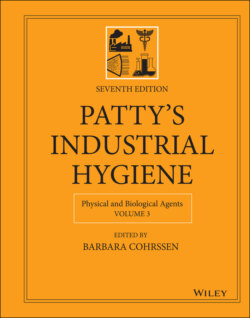Читать книгу Patty's Industrial Hygiene, Physical and Biological Agents - Группа авторов - Страница 93
8 LASER BARRIERS
ОглавлениеLaser barriers are defined in the ANSI Z136.7 standard as “moveable or fixed equipment (devices) used to block or attenuate laser energy,” include curtains or shields that are used for enclosing a “laser controlled area” (see Figure 6). Laser curtains are particularly useful for nonpermanent laser operational situations; for example, where they are put up at an entryway to enclose a “temporary laser controlled area” during servicing. The ANSI Z136.7 standard places a number of obviously important requirements on the materials used in laser barriers, e.g. the material should not be flammable or emit toxic by‐products when irradiated. The manufacturer should specify the material damage threshold for a given time (traditionally 60 or 100 seconds, but now standardized at 100 seconds). This “barrier threshold limit” (TL), or damage threshold, for a fabric curtain ranges between approximately 5 and 350 W cm−2. For metal barriers, the TL will typically be of the order of approximately 1200 W cm−2 for three minutes. Active barriers, such as those with built‐in sensors to shut down laser operation before the barrier fails, have TL values with very high irradiances (Figure 7).
The ANSI Z136.7 standard is not just for the manufacturer of protective eyewear and barriers. The LSO is tasked with the potential need to calculate the separation distance, Ds, of the laser from the barrier if the maximum laser beam irradiance exceeds the TL of the barrier. Typically, in large industrial material processing applications the beam is focused and the beam irradiance decreases rapidly beyond the beam's focal point, and this calculation becomes both useful and necessary.
Manufacturer testing protocols for the TL are provided to determine the highest irradiance incident on a laser barrier for which no penetration occurs for an exposure of 100 seconds and at a specified exposure diameter ranging between 3 and 10 mm. In addition, the test should report the “first visible damage,” or FVD, such as a visually observable change or structural alteration in the protective barriers surface (melting, pitting, cracking, discoloration, and so on) that occurs during or following the exposure; and any flame, smoke or a sign of thermal distortion should be recorded and airborne contaminants must be captured and analyzed for toxic content. A penetration threshold level (PTL) is also to be recorded; this is the initial power level at which beam breakthrough of the material occurs.
The ANSI Z136.7 standard also lists requirements for the manufacturer to provide certain information to the user of a barrier, such as any limitations of use, such as certain applications. A description of an eye‐protective filter optical density with the angular protection afforded by a reflective filter, if applicable, must accompany eyewear. In addition, both groups of products must be appropriately labeled and directions for storage, care, cleaning, and periodic inspections, including any chemical‐exposure warnings are to be provided.
FIGURE 7 Laser barrier curtains used to enclose a “controlled area” where large equipment must move in and out, at entryways or for establishing a “temporary laser controlled area” during servicing.
All laser‐protective barriers must contain labels with certain minimal information, such as manufacturer and the TL and exposure time for which that limit applies and the exposure conditions under which protection is specified.
